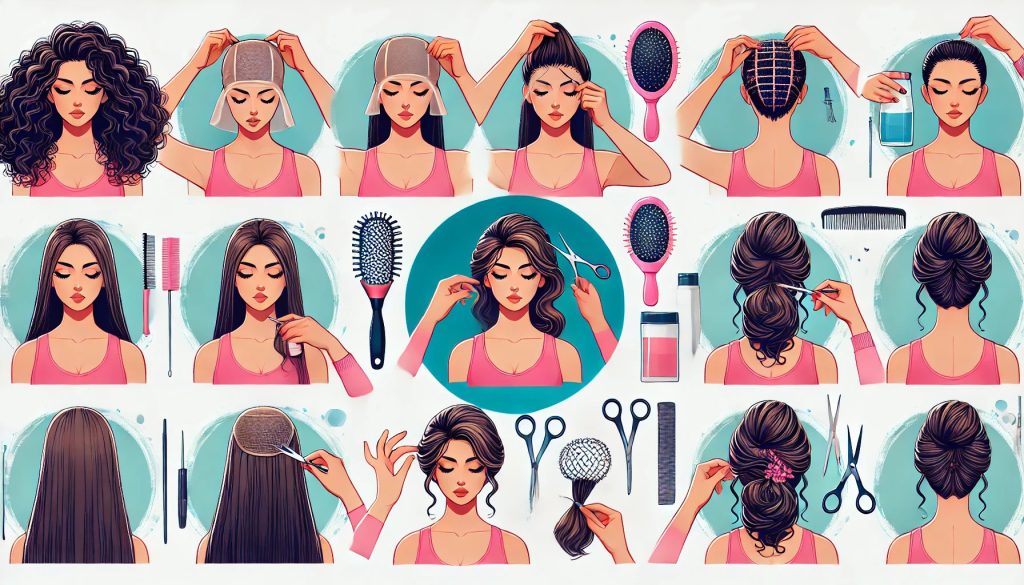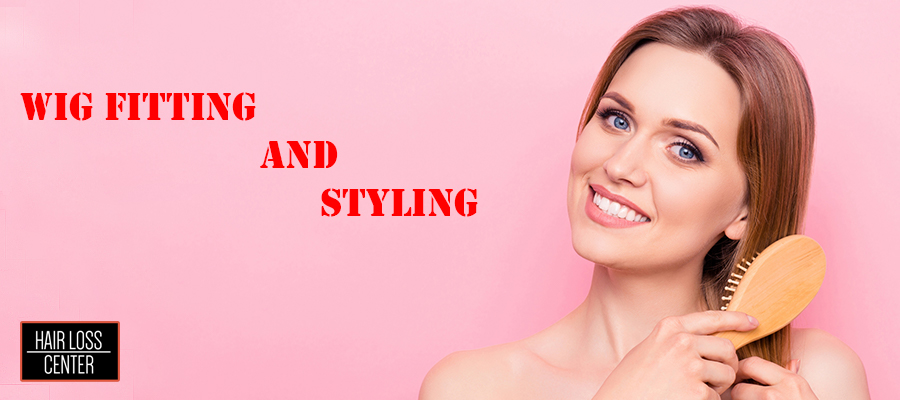Proper wig fitting and wig styling are essential for achieving a natural and confident appearance. First, understanding wig cap construction, such as lace front, monofilament, or full cap, is crucial for selecting the right fit. Factors like head circumference, hair density, and desired style influence wig sizing. Therefore, proper measurement and customization ensure a secure and comfortable fit.
Additionally, styling techniques, including layering, cutting, and heat styling, can transform a wig from ordinary to extraordinary. Mastering these skills empowers wearers to create versatile looks that complement their facial features and personal style.
This article, brought to you by Hair Loss Center San Diego, provides an overview of the essential aspects of wig fitting and wig styling, ensuring you achieve the best results.
Ready to turn heads with the perfect wig? Visit Hair Loss Center San Diego today to explore our expert services and find the ideal wig for you. Don’t wait—seize the day and achieve the natural and confident appearance you deserve! Call us at 858-284-4832 to schedule your consultation.
Understanding Wig Types for Wig Fitting
Choosing the right wig type is crucial for achieving your desired look and ensuring ease of maintenance. Let’s explore the key distinctions between synthetic and human hair wigs to help you make an informed choice. Each type offers unique advantages and considerations based on your lifestyle, budget, and desired look:
Synthetic vs. Human Hair Wigs
Differences in Wig Styling, Wig Maintenance, and Wig Care:
Synthetic wigs are pre-styled and retain their shape even after washing, making them low-maintenance and ideal for those seeking convenience. However, they are less versatile in terms of styling options compared to human hair wigs. Human hair wigs, on the other hand, offer the most natural look and feel. They allow for a wide range of styling possibilities, including heat styling. They require more care and maintenance, similar to natural hair, to keep them looking their best.
Pros and Cons of Synthetic Wig Styling vs. Human Hair Wig Styling:
Synthetic wigs are generally more affordable and come in a variety of styles and colors. They are also resistant to weather conditions, maintaining their style in humidity or rain. However, they cannot be heat-styled and may have a shorter lifespan. Human hair wigs, while more expensive, provide unmatched versatility and a natural appearance. They can be cut, colored, and styled just like natural hair, but they require regular maintenance and care to preserve their quality.
Lace Front vs. Full Lace Wigs
Choosing between lace front and full lace wigs can significantly impact your wig-wearing experience. Each type offers distinct advantages and customization options, making it essential to understand their differences:
Wig Application Techniques for Lace Front and Full Lace Wigs
Lace front wigs feature a sheer lace panel along the front hairline, creating a natural-looking hairline illusion and versatile styling options. They are typically applied using wig adhesive or tape along the lace edge, ensuring a secure fit. In contrast, full lace wigs have a lace base that covers the entire scalp, providing the most natural look and maximum styling flexibility.
Full lace wigs can be parted anywhere and styled in updos or ponytails, offering a seamless appearance from all angles, including the nape of the neck. The application process for full lace wigs involves securing the lace around the entire perimeter of the head, often requiring more skill and precision.
Wig Customization Options for Different Wig Types
Both lace front and full lace wigs offer various customization options to suit individual preferences. Lace front wigs can be customized by trimming the lace to match your natural hairline and adding baby hairs for a more realistic look. Additionally, they can be styled with heat tools, allowing for different hairstyles. Full lace wigs provide even greater customization possibilities. They can be dyed, bleached, and styled in any direction, mimicking the versatility of natural hair. The lace material can also be tinted to match your skin tone, enhancing the wig’s natural appearance.
Using the right wig accessories can further enhance the fit and look of both types, making them confidence-boosting additions to your wardrobe. Whether you choose a lace front or a full lace wig, understanding these customization options can help you achieve a personalized and flawless look.
Factors to Consider for Proper Wig Fitting and Wig Sizing
Achieving a seamless and comfortable wig experience requires careful consideration of several key factors. This ensures that the wig sits securely and comfortably on your head:
• Cephalic circumference: Precise measurement of the head to determine the appropriate wig base size.
• Hair density: Balancing fullness and natural appearance by selecting the right hair density for your desired look.
• Wig cap construction: Understanding different cap types (lace front, full lace, monofilament) and their impact on fit and appearance.
• Desired hairstyle: Considering the desired hairstyle and selecting a wig base that accommodates it.
• Facial shape and features: Assessing how the wig complements your facial structure for a harmonious look.
Importance of Understanding Wig Cap Size for a Comfortable Fit
Achieving a comfortable and natural-looking wig starts with accurate sizing. Measure your head circumference at the hairline, over the ears, and around the nape of your neck. Compare this measurement to standard wig cap sizes (petite, average, large) to determine the best fit. If you fall between sizes, consider the wig’s adjustability features, such as straps or elastic bands, which can help achieve a snug fit. Consider factors like head shape and desired style for optimal results. Remember, a well-fitted wig enhances both comfort and appearance.
Different Wig Cap Sizes and Their Significance in Wig Fitting
Wig caps come in various sizes, typically categorized as petite, average, and large. Each size corresponds to specific head measurements. For instance, a petite cap usually fits head circumferences of 20 to 21.5 inches, an average cap fits 21.5 to 22.5 inches, and a large cap fits 22.5 to 24 inches. An ill-fitting cap can lead to discomfort, slippage, and an unnatural appearance, making it crucial to select the right size.
Measuring Your Head for a Wig
Accurate head measurements are crucial for achieving a perfect wig fit. Follow these steps to obtain precise measurements:
- Cleanse your hair: Wash and dry your hair to avoid interfering with the measurement process.
- Gather your tools: Prepare a soft measuring tape and a pen and paper.
- Measure the circumference: Wrap the measuring tape around the largest part of your head, just above the eyebrows and ears.
- Mark the measurement: Note the measurement in inches or centimeters for reference.
- Determine your desired style: Consider your preferred hairstyle and how it will influence wig selection.
- Consider additional measurements: For custom wigs, additional measurements may be required, such as the distance from the hairline to the nape of the neck.
- Consult with a professional: If unsure about measurements, seek assistance from a wig specialist for accurate results. Clearly express your expectations and preferences to your wig stylist for personalized recommendations.
Transform your style with a perfect wig fit! Book your consultation at Hair Loss Center San Diego today and discover the incredible impact of expert advice. Call us at 858-284-4832 now and take the first step towards a new you!
Techniques for Preparing Natural Hair Before Wig Application
Before wig application, it’s important to prepare your natural hair to create a smooth and flat surface. Start by washing and conditioning your hair to ensure it is clean and free of any product buildup. Next, braid or twist your hair into small, flat sections to minimize bulk and create a seamless base for the wig. If your hair is short, simply brush it back and secure it with bobby pins. For added security, use a wig cap to hold your hair in place and prevent it from shifting under the wig. This step is crucial for achieving a natural look and ensuring the wig fits snugly.
Steps to Secure Your Wig
A secure wig is essential for all-day comfort and confidence. Several methods can be employed to keep your wig in place:
- Wig adhesive: Use a high-quality wig adhesive for a strong and long-lasting hold.
- Wig tape: Double-sided wig tape provides additional security, especially for lace front wigs.
- Wig grips or bands: These accessories help to prevent slippage and create a secure fit.
- Wig clips: Small clips can be used to secure the wig to your own hair for added stability.
- Proper fitting: Ensure the wig cap size is correct and the wig is positioned accurately on your head.

Styling Your Wig for a Natural Look
Styling your wig can significantly enhance its appearance and create a natural look. Here are some essential tips:
- Choose the right tools: Use a wide-tooth comb or wig brush to avoid damaging the hair fibers.
- Start with a clean wig: Wash and condition your wig regularly to maintain its style and prevent tangles.
- Create layers: Add dimension and movement by layering the wig’s hair.
- Bangs and partings: Experiment with different bang styles and partings to achieve your desired look.
- Heat styling: Use heat styling tools cautiously, as excessive heat can damage synthetic hair.
- Wig styling products: Utilize wig-specific styling products for hold and definition.
- Professional styling: Consider consulting a wig stylist for expert advice and styling techniques.
Essential Wig Styling Techniques
Proper wig care and styling are crucial for maintaining a natural appearance and extending the wig’s lifespan. Gentle wig combing and wig brushing with a wide-tooth comb help prevent damage and tangling. Additionally, wig-specific styling tools and products are recommended for optimal results. Techniques such as wig cutting and wig shaping can enhance the wig’s fit and style.
For more advanced styling, wig curling and wig straightening can be achieved using wig heat styling tools designed for synthetic or human hair wigs. However, always exercise caution to avoid damaging the fibers. Experiment with different styles to find the perfect look that complements your face shape and personal style. Watch a tutorial here.
Common Wig Fitting Mistakes
Avoiding common wig-fitting errors is crucial for achieving a natural and comfortable look. Several mistakes can compromise the overall appearance and wearability of a wig.
- Incorrect measurements: Taking inaccurate measurements can lead to a poor fit, making the wig uncomfortable and unnatural-looking.
- Neglecting wig cap size: Overlooking the importance of the wig cap size can result in a wig that doesn’t stay securely in place.
- Ignoring hair preparation: Failing to properly prepare your natural hair can affect how well the wig sits and looks.
- Over-styling: Excessive styling can damage the wig fibers, reducing its lifespan and appearance.
- Neglecting wig maintenance: Skipping regular cleaning and care can lead to tangling, matting, and a shorter wig lifespan.
FAQs About Wig Fitting And Styling
How Can I Avoid Discomfort During Wig Application?
Ensure proper wig fitting and use wig accessories like wig caps and grips. Adjust straps and combs for a secure yet comfortable fit. Use wig tape or adhesive sparingly to avoid pressure on the scalp.
What are some styling techniques for short, medium, and long wigs to achieve a natural look?
- For short wigs, use light products to add texture to pixie cuts. Applying a minimal amount of pomade can help piece out bob styles, giving them a soft and natural appearance.
- For medium-length wigs, try creating loose waves with a large barrel curling iron. Alternatively, achieve sleek looks with a straightener, but always use heat protectant sprays to preserve the wig’s quality.
- For long wigs, you can create various styles such as beachy waves, voluminous curls, or sleek straight looks. Using the right styling tools and products, like heat protectants and wig-specific sprays, will help maintain the wig’s natural appearance and longevity.
How Do I Prevent My Wig from Slipping in Wig Fitting And Styling?
Use wig adhesive and wig accessories like wig grips or bands. Ensure proper wig application and fitting for a secure hold. Moreover, Wig caps, grips, and bobby pins secure your hair and wig for a comfortable fit.
How often should I trim my wig?
Regular trims can help maintain the shape and style of your wig. Depending on wear and styling, consider trimming every 6-8 weeks, similar to natural hair.
What should I do if my wig feels too tight or too loose?
Most wigs come with adjustable straps or elastic bands. Adjust these to achieve a snug but comfortable fit. If the wig still doesn’t fit properly, consult a wig specialist for further customization.
Achieving a Natural and Confident Appearance with Wig Fitting
Achieving a natural and confident appearance with a wig involves understanding the intricacies of wig fitting and styling. By selecting the right wig type, accurately measuring your head, and mastering styling techniques, you can transform your look effortlessly. Whether you prefer synthetic or human hair wigs, lace front, or full lace, the key is to customize and care for your wig to suit your personal style and needs. For expert guidance and a flawless wig fit, visit Hair Loss Center San Diego and schedule your consultation today. Call us at 858-284-4832 to get started on your journey to a perfect wig fit. At our Center in San Diego, we offer a range of services including custom human hair wigs, wig fitting, and personalized consultations. Learn more about our services here.


